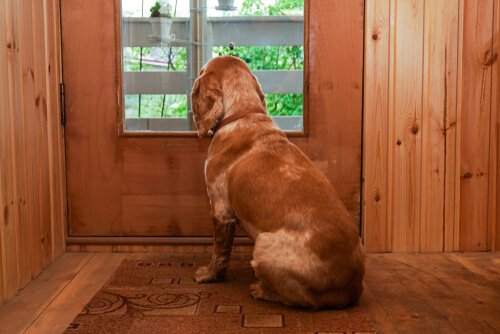Why Does Your Dog Cry When You Leave?

The fast pace of city life means people don’t spend too much time at home. Thus, there isn’t that much time in the day to be with your pet, so sometimes they might get sad and begin to cry. However, what really causes this behavior? Why does your pet cry when you leave the house?
Since dogs are extremely social animals, they don’t enjoy being alone. In addition to crying, they might develop aggressive behaviors and maybe even destroy things in the house. Therefore, it’s very important to understand why this takes place and find ways to manage their loneliness.
How does solitude affect dogs?
Most humans and pets enjoy small doses of alone-time on a daily basis, but never in excessive amounts. Most people don’t want to be alone all the time, and especially dogs.
You by having a lack of free time means you can’t spend that much time with your dog. This eventually causes negative physical and psychological effects on your dog. If he cries when you leave the house, you might be leaving him home alone too often.
When your dog knows that he is going to spend “long hours” alone at home, he will behave poorly to grab your attention. Their aggressiveness, destructive behavior, repeated movements, whimpering, continuous barking, and crying, are all common methods dogs use to express their feelings.

It’s important to distinguish between separation anxiety and loneliness. The latter happens when a dog is distanced from his key figure (mother, sister, or a certain human family member). He may show a heightened state of stress even while he’s with other family members.
Reasons why your dog might be crying
Just like their closest relatives, wolves, dogs are social animals that generally live in packs. Even living in a home environment, won’t totally diminish these instincts. Instead humans adopt them into a different pack: our families.
Dogs cry when they are left alone because they have a natural tendency for separation anxiety and sadness.
Possible traumas from the past could be another factor in developing this negative behavior. Abandoned puppies were often treated very badly before being adopted, so their fear of being alone makes them even more nervous.
Another reason your dog cries could be due to bad habits taught by the owner. Failing to educate your dog to correctly process alone time might also cause an attachment disorder. Yous should always try to prevent that from happening in order to have a healthy relationship with your pet.
Separation anxiety
This behavior is most likely influenced out of fear. If your dog feels threatened or endangered, it will go on high alert and may damage household items, crying, and desperation.
Uncontrollable anxiety is natural for animals that typically live in packs. At least 15% of the canine population suffers from it. If you don’t pay enough attention to his behavior, the dog might become unhappy, stressed, or anxious.

Advice for stopping your dog from crying
It’s incredibly important for your pet to learn how to be alone. If your dog cries when you leave the house, you must train him to overcome stress and entertain himself while you’re gone. You can give fun toys — such as bones, things to bite, little puzzles — to manage your dog’s anxiety is a good first step.
A comfortable, warm, and quiet environment will help your dog feel comfortable. A soft bed will give him a safe space and improve his mental stability. It’s sometimes advisable to leave a radio on so that he doesn’t sit in absolute silence.
Taking a walk before leaving the house is another good activity if you dog cries when you go. Exercise will tire him our and he’ll sleep while you’re away. If you’re leaving for a long period of time, feed your dog just before exercising to avoid stomach problems and to reduce his anxiety.
One great option, if you have the means and the interest, is to adopt another dog to keep your pet company. This is not a decision to take lightly, and you must assume all responsibility for getting another animal. In order to assure a healthy relationship between the two dogs, you must introduce them to each other at the right time and in the right manner.